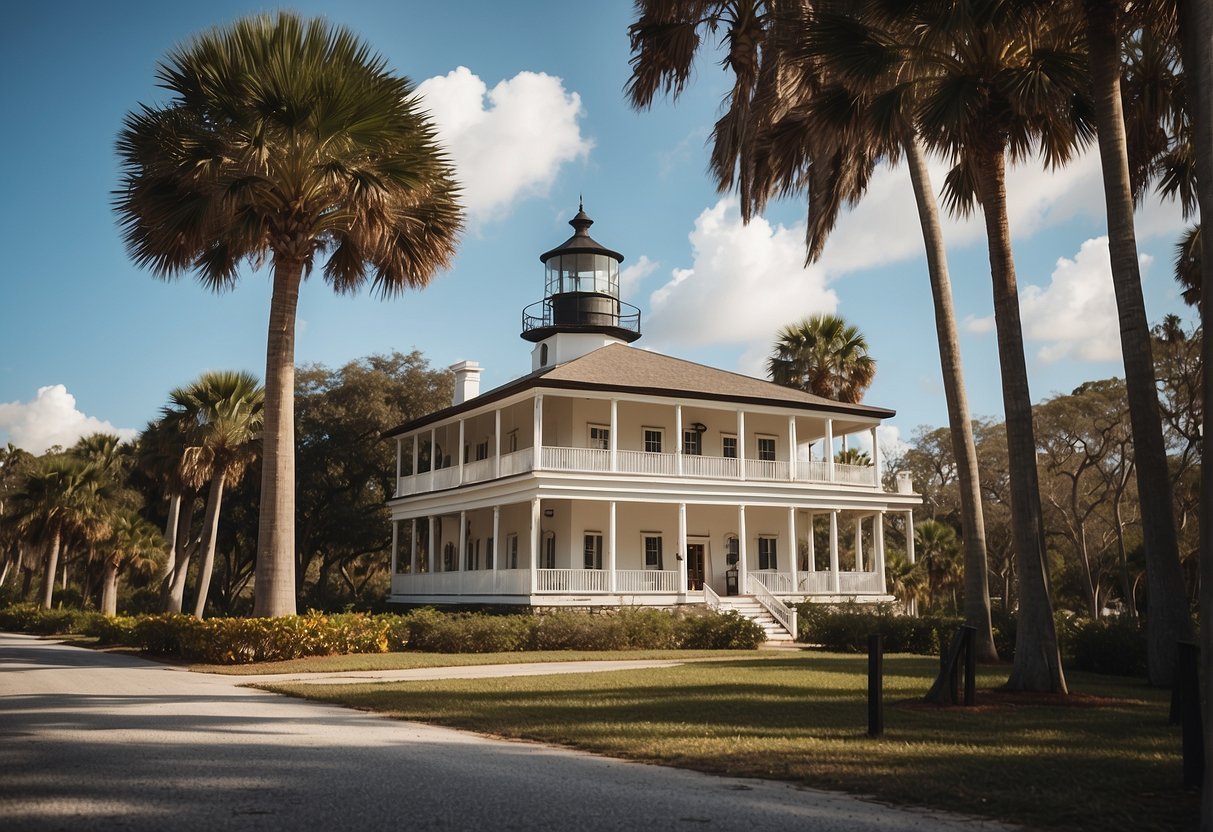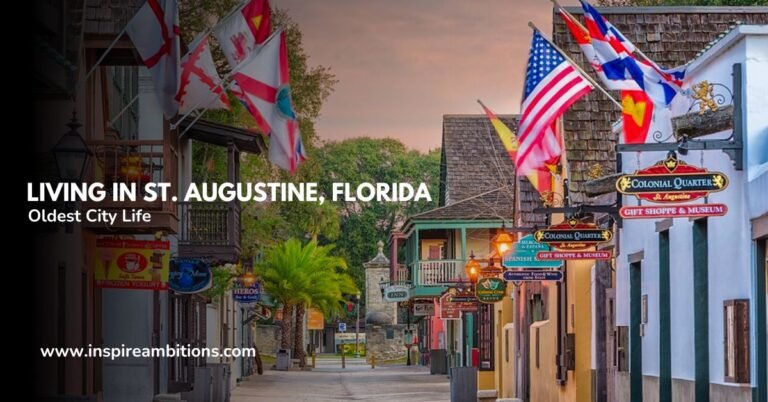フロリダの史跡 – サンシャイン ステートの文化遺産ガイド
Florida, the Sunshine State, is renowned for its 自然のままのビーチ, balmy weather, and rich tapestry of history embedded in numerous historic sites scattered across the state.
From the crumbling forts on the Gulf Coast to the grand plantation homes further inland, these sites serve as a testament to the multifaceted cultural heritage that has shaped Florida over the centuries.
These locations offer a captivating glimpse into the past, where each landmark tells a unique story of the defining moments and periods that have left an indelible mark on the state’s identity.

Historic Sites in Florida – Key Takeaways
- Exploring these historical sites is a journey through Florida’s diverse cultural landscape, reflected in the various architectural styles, from Spanish colonial to Greek revival, that characterise these characteristics of the past. Not only are these sites one era. Still, they also use sandstone for conservation efforts and educational endeavours, ensuring that future generations can understand and appreciate the significance of preserving Florida’s historical heritage. For anyone seeking to visit these historical sites, it is imperative to connect with Florida’s enduring spirit and legacy. Visiting these hida’s historic sites is integral to understanding the state’s rich heritage.
- Each site offers unique insights into the architecture and culture of past eras.
- Preservation and engagement with these sites are essential for cultural education.
Key Historical Period Criticalnd Events

Florida’s rich tapestry is woven with pivotal moments, from early Spanish conquests to civil unrest and seminal 文化遺産. Here, you’ll explore the landmarks where history was made and the events that shaped the Sunshine State.
Spanish Exploration and Settlement
The dawn of European history in Florida can be traced back to the arrival of Spanish explorers. St. Augustine, founded in 1565 by Pedro Menéndez de Avilés, is the oldest continuously inhabited European-established settlement within the borders of the United States.
象徴的な Castillo de San Mariss is a testament to Spain’s once-mighty presence, a star fortress constructed to ward off attacks by Florida’s would-be conquerors and pirates.
Civil War and Reconstruction
During the 内戦, Florida was the third state to secede from the Union and join the Confederate States of America. Conflicts such as the Battle of Olustee marked Florida’s landscape, and the war’s aftermath saw a challenging Reconstruction period as the state struggled to rebuild and reintegrate into the Union.
Throughout this era, national politics and policies were influenced significantly by the office of the President as the nation worked toward unification once again.
The Second Seminole War and Native American Heritage
の Second Seminole War (1835-1842), fought between Native American Seminoles and the United States, was a defining clash in Florida’s history.
This period saw the profound resistance of the Seminoles against forced removal from their lands. Several sites across Florida reflect the rich cultural legacy and enduring spirit of the Native Americans, with the war serving as a grim reminder of the cost of colonisation and colonisation the resilience of the Seminole people.
Prominent Historic Sites and Monuments

Florida houses many historical sites that offer a glimpse into its diverse past, from military engagements to cultural developments. Discover forts that have stood the test of time, explore opulent homes set in lush gardens, and reflect on landmarks that tell the cultural tales of Florida.
Forts and Military Landmarks
- ドライ トートゥガス国立公園: Reachable only by boat or seaplane, this remote park lies approximately 70 miles west of Key West and is home to Fort Jefferson, one of the nation’s largest 19th-century forts.
- Castillo de San Marcos National Monument: This is the oldest masonry fort in the continental US. It is located in St. Augustine and tells the story of various cultures throughout its history.
- Fort Matanzas National Monument: Guarding the southern approach to St. Augustine, this fort has watched over the waters since 1742.
Stately Homes and Gardens
- Vizcaya Museum & Gardens: The former villa and estate of businessman James Deering is now housing a museum in its Italian Renaissance-style building, offering a look into early 20th-century opulence.
- Kingsley Plantation: Located on Fort George Island, Kingsley Plantation, part of the Timucuan Ecological and Historic Preserve, offers insights into the lives of free and enslaved people who lived here in the early 19th century.
Cultural and Civic Landmarks
- Lightner Museum: Situated in St. Augustine, the museum occupies the former Alcazar Hotel built by Henry Flagler and displays collections from the American Gilded Age.
- National Register of Historic Places: Locations across Florida on this list span a wide range of historic periods, demonstrating the state’s rich cultural heritage.
Images and multimedia referenced in the article should be optimised with desoptimised text, incorporating keywords relevant to the topic to provide context for search engines and assistive technologies. They enhance understanding for all readers and are particularly helpful for those using mobile devices. Ensure your engagement with the historical lore of Florida continues by sharing your experiences in the comments, or delve deeper by exploring related articles and resources.
Conservation and Education
In Florida, protecting historical sites is as crucial as sharing their stories. Conservation efforts and educational programmes are pivotal in preserving these cultural treasures for future generations.
Preservation of Historic Sites
- State Park and National Park Service Involvement: Both Florida State Parks and the National Park Service are at the forefront of preserving historical sites in Florida. They manage numerous properties, ensuring sensitive restoration and maintenance that honour the integrity of these locations. For example, the National Register of Historic Places in Florida lists over 1,800 sites, with many located within these protected parklands.
- Department of the Interior and State Efforts: The Department of the Interior plays a substantial role by collaborating with state agencies such as the Florida Division of Historical Resources to safeguard landmarks. These collective efforts ensure preservation standards are met and sustained.
Educational Programmes and Tours
- Florida State Park Tours: Florida’s 州立公園 offer a diverse range of ガイド付きツアー to educate visitors about the historical significance of each site. Visitors are often invited to explore historical forts, homes, and Native American sites, enhancing their understanding of local history.
- National Parks Educational Initiatives: National parks also deliver programmes to educate the public. Each park aims to provide an immersive educational experience, from on-site guided tours to interactive visitor centres. These initiatives encourage active participation in the conservation of these precious sites.
Cultural Impact and Legacy
Florida’s historic sites are not simply markers of the past; they shape the present culture and continue to influence modern life. These sites range from Key West Lighthouse to the vibrant cityscapes of Miami and Tampa, encapsulating the essence of American history and engineering.
Influence on Modern Florida
Florida’s blend of cultural heritages and rich history is reflected in the eclectic mix of architectural styles, from Sarasota’s Mediterranean Revival to the tropical Art Deco of Miami-Dade County. Here’s how these historic sites impact the state today:
- Miami and Key West: Both cities draw millions of tourists annually, with Miami’s art scene and Key West’s maritime heritage contributing to Florida’s tourism-driven economy.
- Tampa Bay Hotel and Daytona Beach: These locations have become central to the community’s social and cultural events, directly influencing the vibrancy of local life.
- Lake Wales and Fernandina Beach on Amelia Island continue honouring their past through restoration efforts and educational programs, fostering community pride and maintaining the legacy for future generations.
Recognition in Arts and Media
Historic sites in Florida have been immortalised, impacting perceptions and offering a lens into periods of profound change. Here are specific influences:
- Dade Battlefield and St. Johns River: Narratives surrounding these sites are often featured in literature and documentaries, providing insights into the pivotal moments of Florida’s past.
- Maitland Art Center and Daytona Beach: These locations host exhibits and festivals and are celebrated subjects in various artistic endeavours.
- Pensacola’s Historic Sites and Tampa Bay Hotel: Their dramatic architecture and stories have made their favourite subjects and backdrops in films and photography, capturing the imagination of audiences worldwide.
Whether through a gift shop that sells souvenirs or a statue that sparks a conversation, Florida’s historic sites act as conduits for cultural transmission, blending yesterday’s heritage with today’s dynamic Florida.






